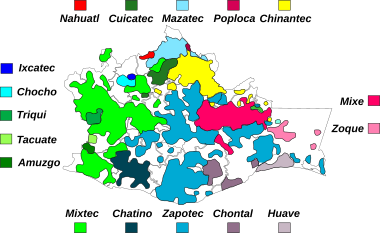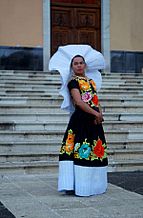Sexuality and gender in Zapotec Oaxaca facts for kids
This article is about the significant amount of academic and social interest focusing on the dynamic of gender within the region of Oaxaca that has a high volume of indigenous Zapotec individuals.
Contents
Zapotec presence
The country of Mexico has a high population of indigenous communities that can be found throughout the entire country. Michelle Muñoz Cisneros recognizes the various indigenous groups that span throughout the entire county, citing the Comisión Nacional para El Desarrollo de los Pueblos Indigenas which confirmed 68 communities indigenous to Mexico. A heavy indigenous presence is located in more southern regions of Mexico, specifically the state of Oaxaca. Within Oaxaca, 65.7% of the population are indigenous to the 16 groups identified. While 57% of Oaxaca's population specifically identifies with the indigenous groups of Zapotec and Mixtec.
The presence of the Zapotec group has been traced back to around 10,000 years ago along with similar groups such as Mixtec. The native language family of Oto-manguean is used by the Zapotec community and has been prevalent throughout the years. In a study from 2005 by the National Institute of Statistics and Geography, they gathered data of 410,901 individuals throughout Mexico who stated that they were fluent in indigenous Zapotec languages. Of this pool, 87% of individuals who claimed to speak Zapotec languages resided in Oaxaca. Each of these statistics demonstrate the prominent presence of the Zapotec individuals in Oaxaca, which is further elaborated in mentioned academic articles.
Academic research
Academic research such as Lynn Stephens article Gender in Zapotec Oaxaca explore how gender is understood within this region based on her archival research of the impacts of colonialism and through her observations during her stay in the small cities of Juchitán de Zaragoza and Teotitlán del Valle both cities found in the state of Oaxaca. Stephens describes a common understanding in the state of Oaxaca, that there is a strong sense of regional pride, established gender roles, and indigenous roots that are present. Further analyzing how many individuals actively participate in keeping these traditions and culture alive. Specifically, her research focuses on the high population of Zapotec individuals found in the regions such as Juchitán de Zaragoza or Teotitlán de Valle, Oaxaca. In these communities she describes a normalization and consistent use of Zapotec languages, the inclusion of the third gender Muxe, and the continuation of culturally significant formal events known as velas. Stephen examines how the understanding of gender in Zapotec culture has been influenced by migration, colonialism, and class division. Ultimately, the impacts of each of these outside forces create an understanding of designated roles for each gender and representation of these gender identities in different contemporary settings.
Indigenous gender identity
Muxe
The gender of Muxe is defined as an indigenous Zapotec third gender that defies the common binary option of female or male. Definitions are provided in Lynn Stephen's piece Gender in Zapotec Oaxaca and Alfredo Mirandé article Hombres Mujeres: An Indigenous Third Gender. Alfredo Mirandé defines muxes as:
"Muxes are biological males who also manifest feminine identities in their dress and attire, but they are not transsexual nor are they seeking to become women. They both self-identify and are generally recognized and accepted as a third gender, rather than as men or women, adopting characteristics of each gender."
The identity of muxe is categorized as a third gender because they do not subscribe to the binary option of male or female, nor do muxes label themselves as either of those options in any environment. Muxes are not restricted to a specific physical appearance, many muxes present themselves in a range of ways. Some muxes choose to dress in traditional female Zapotec clothing, wear makeup, or even present a masculine aesthetic. There is not a set of criteria of how muxe must present themselves, rather there is a set of expectations that both Zapotec muxes and women share.
Designated gender roles
Within the Zapotec community there are specific roles and responsibilities placed on the identity of women, men, and the indigenous third gender muxes.
Roles of Zapotec muxes and women
Workforce
In the case of Juchitán de Zaragoza, Oaxaca Stephen discusses how the Zapotec culture has an understanding that it is not a community that places matriarchs as designated leaders, it is more of a patriarchal community. However, the women often take on the responsibility of being leaders and the labor that comes with running the local business settings such as the mercados or the stores of the town. As mentioned in both pieces from Mirandé and Stephen, there are assigned responsibilities for women and muxes which revolve around the functionality of these local markets. Women and Muxes are often assigned responsibilities that are categorized as either “heavy work,” and “intermediate activities”. Hard labor includes working, preparing, and running the markets and annual community gathering known as “velas,” which is a regional celebration. Velas include mild labor from women and muxes because they are assigned the tasks of preparing the decorations for this celebration that happens for several. Women and Muxes also share the responsibility of embroidering clothing and decorating altars. Mirandé states that despite the separation of gender roles within the workforce, there is an appreciation of the work ethic of women and muxes; the characteristic of being “hardworking” is often identified as a feminine trait. Through the academic observations of Mirandé and Stephen, their observations describe the separation of gender roles assigned for women and muxes in comparison to men.
Reproduction
Another major responsibility that is expected specifically from cisgender women includes the role of reproduction. Within Stephen's article she argues that sexist ideology and hierarchy are still present in indigenous Zapotec communities in Oaxaca due to colonial practices such as “purity of blood”. This concept is very similar to the practice of limpieza de sangre (cleaning of blood) which entails that elite communities continuously practiced the exclusion of “the blood of Jews, Muslims, and heretics” within their genealogy. This responsibility was placed onto the shoulders of women and if reproduction were to occur with individuals a part of demographics who were seen as inferior it would directly impact the reputation of these women. Stephen argues that the practice of limpieza de sangre enforces the heteronormative role of reproduction placed onto women; a practice that is not rooted in indigenous practice or ideology, rather through colonial influences. Ultimately, concluding that this Spaniard ideology has impacted how gender and gender roles are viewed within present-day Zapotec communities.
Community gatherings: velas
A final difference in roles between men, women, and muxes that is highlighted in academic research is during the traditional velas de Juchitán de Zaragoza. Stephen introduces this annual event and defines it as “elaborate several-day celebrations involving processions, masses, food preparation and blessing, drinking, and dancing”. This is an event that takes hard work from everyone in the community. Yet, velas are “defined as women’s domain” because they do take on the majority of the work to prepare for this event. Muxes are often assigned the responsibility of crafting the traditional Zapotec clothing for those attending. Despite these examples not being representative of all the contributions of the residents, it presents a preview of the designated roles given on the basis of gender.
Muxe representation
Representation of the indigenous Zapotec community, their traditions, and the third gender of muxes is seen on social platforms such as Netflix, Instagram, YouTube, and magazines. Documentaries that attempt to showcase the lives of muxes are the Third Gender: An Entrancing Look at Mexico’s Muxes | Short Film Showcase by National Geographic and Muxes -- Mexico’s Third Gender by The Guardian which can be found on YouTube. Muxes have also made the cover of Vogue México in 2019 which included the article Muxes: El Tercer Género Que Vive en México Desde Tiempo Inmemoriales by author Karina Gonzalez Ulloa. The 2019 December cover of Vogue Mexico has the portrait of Estrella, a muxe from Juchitán de Zaragoza. Estrella is also interviewed in The Guardian's documentary that was previously mentioned. Finally, a muxe named Marven Lady Tacos de Canasta has a substantial following on social media. Currently, Marven Lady Tacos de Canasta has 70.7k followers on Instagram and has been featured in the popular Netflix original series the Taco Chronicles (specifically, Taco Chronicles V1: E3 “Canasta”).




